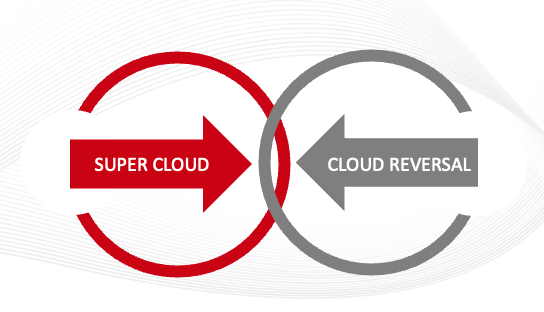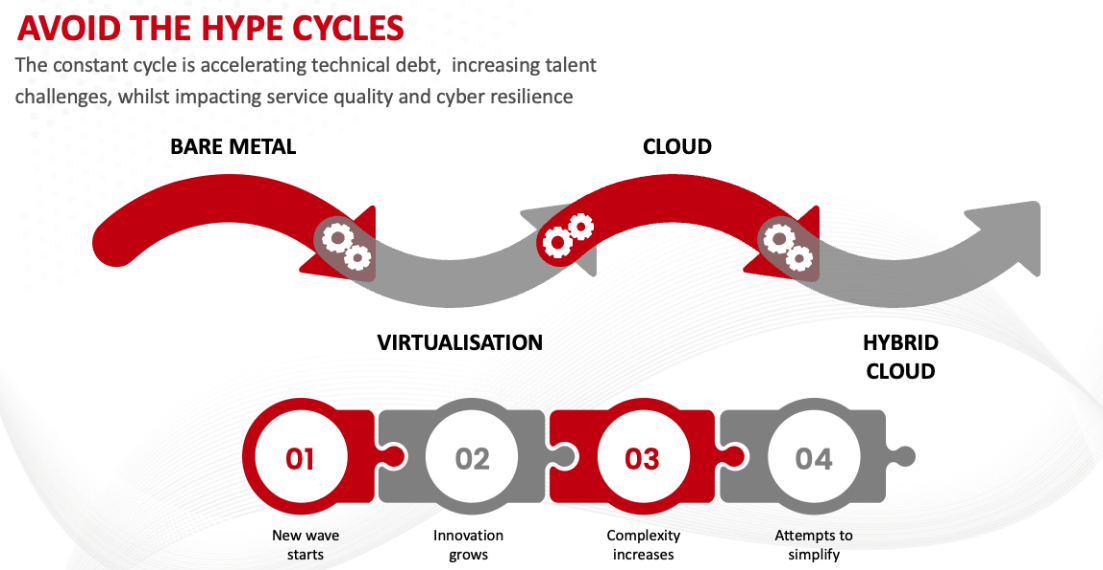A trending topic in 2023 and into 2024 has been that of cloud reversal, or repatriation. For those who have missed the term, it is the trend of workloads being moved out of public cloud providers either to local service providers or customer-operated platforms.
In this three-part series, we will explore the following topics:
- Why are we having this conversation?
- Cloud when right and relevant; our Right Workload | Right Platform approach.
- Cloud adoption done right - how to avoid the pitfalls.

Contents:
- Why is this a conversation?
- Impact of following the hype
- Poor assessments driving strategy
- Lift-and-shift challenges
- AI impact
- The world has moved forward
Why is this a conversation?
So why are we talking about cloud reversal or repatriation in 2024? With cloud spending expected to reach $679 billion in 2024, something is working well in the public cloud - so why leave? The simple answer is that we have the wrong types of workloads in the cloud and the cost/benefit equation is not balancing (in some cases). This is not a new thing; we see similar cycles in our industry all the time, not just in platforms but in other areas like Modern Workspace. We adopt a new technology and several years later revert to a modified version of an earlier operating model.
The question is, why has this happened? By understanding the history we can make sure to avoid repeating the mistakes.
IMPACT OF FOLLOWING THE HYPE CYCLE
One of the big factors impacting current cloud reversal is what we like to call the Hype Cycles. We see a new technology appear and adopt it as the solution to all our challenges. Then, just as everyone starts to realise that dream might not materialise, another cycle starts and we jump again. The amount of technical debt this process leaves behind is scary and has a massive impact on talent, service quality and cyber resilience.
Think back to the time mainstream virtualisation (VMware) was mature and the cloud was gaining traction. The VMware estate looked big and cumbersome, and the cloud looked new, shiny and easy. We had new technologies come to market to try and curb the perceived VMware complexity (Nutanix, VxRail etc.) whilst the public cloud promised to solve all challenges. Some jumped without really understanding the cost or impact, sometimes based on poor assessment data and sometimes as a lift-and-shift, only with unrealistic transformation goals.

Following these hype cycles without a plan to manage the potential technical debt or ensure the value is realised will lead to more technology reversal conversations in the years to come.
POOR ASSESSMENTS DRIVING STRATEGY
I would like to say this was only a challenge in the early days of the public cloud, but it continues today. We see poor cloud migration assessments that promise savings and easy migrations, which get you on the journey and then cost-spiral as the 'add-ons' materialise. Or we see decisions made without fully understanding the long-term costs or mechanics of cloud billings. How many times have you heard of 12 or 24 months of budgets being spent in the first 6 months? Or migrations that are halted due to spiralling costs?
Cloud assessments ran by an entity that may have a vested interest in the result - such as a Cloud transformations services provider - are never the optimal place to start one's journey. It might cost a little more upfront but commissioning an independent assessment could save a lot in the long run, whether that be commercially or in time.
LIFT-AND-SHIFT CHALLENGES
Another past trend that is now driving reversal conversations is projects based purely on 'lift-and-shift', i.e. just picking up a load of virtual machines and running them 24x7 as IaaS instances. For those that could maybe close a data centre and make the savings this brings, this model can work, but for many this is either not possible (legacy workloads) or does not happen (failure to complete migrations), leaving the original ROI objectives unobtainable.
In many cases, although the plan was to migrate and then modernise, that second step rarely materialises, leaving the cost profile untenable. Public cloud excels at running modern application architectures; providing access to new and unique services and that burst scale that some organisations thrive on, running static VMs tends not to work out as well (in some cases).
The other challenge we see in this space is not adapting the internal Operating Model to take advantage of the cloud features. If you are going to land workloads on the cloud then you need to evolve people and processes to take full advantage and extract the value.
AI DRIVING EDGE USE CASES
The need to either process or extract value from data generated at the Edge is growing and being driven more in recent times by the AI hype. While this might not be directly driving workloads out of the cloud, it is generating use cases for non-cloud compute and storage instances to be stood up. Once in place and the cost models understood other workloads tend to follow to optimise costs.
THE WORLD HAS MOVED FORWARD
Thankfully, I see some of the above challenges becoming less common and the organisation starting to understand the true meaning of that cloud-first strategy. It does not mean cloud-only; it should be a decision tree based on business factors that lead to workloads being placed in the correct execution location (more on that in the next part of this series). The more organisations that truly adopt this mantra, the less chance we will be talking about reversal in the years to come.
The pressures on organisations have increased in the last few years as well. Governance and compliance laws (GDPR, DORA, NIS2 etc) and sovereignty requirements are driving different architectures. Our most modern customers are embracing true hybrid cloud models that allow them to meet these requirements with a sustainable financial model.
SUMMARY:
Don’t get me wrong, this is not a negative public cloud rhetoric. It’s about tools being used for the correct job. Hammers are great and so are spanners, but you won’t get far using that spanner to knock a nail in! For some, this might all seem obvious, but I believe it needs to be said so that everyone is on the same page and can avoid the pitfalls of previous projects.
In the next part of this series, we will explore when to use the cloud and when not to, as part of our Right Workload | Right Platform mantra here at CDW. The aim is to use the correct tools for every job!
NOTE: A nice article from cio.com outlines further some of the thoughts around this.

